
So often it is the elders who remember tales through their time spent recounting orally the comings and goings of the past. Here Amne Machin is a backdrop of life.
Breakfast often brings realizations – some stimulated by the first thoughts of the day and others brought to life from without. Tucking into bowl after bowl of milk tea this morning comes with a nugget of information imparted almost casually, which reminds me very clearly of what is key to this journey. It has to do with salt.
Muscle pain is thrown aside as this new tad of information settles in. We are nine people tucked into a square room no more than three metres square. Two beds, a wood stove, a makeshift altar and Michael and I trying unsuccessfully to shove our legs and filthy boots somewhere where we aren’t tripping people up.
My question comes amidst a full mouth of tea and tsampa (barley powder) and there are subsequent sprays of powdered barley as I bark out my query about salt.
“Was salt transported here by caravan”?
A middle-aged man with tawny eyes and large hands issues the answer and it is straightforward.
“Of course. Salt was always being moved around and there used to be a tsaka (place of salt) close to here”, he continues, “Traders often used these pilgrimage routes as trade routes”.
Somehow just hearing the words again, hearing this most informal of confirmations from a local lights up the morning. Within the landscapes that we have been traveling the land and elements have at times overshadowed the mineral itself. Here the daily doses of the spectacular overwhelm all, but suddenly and reassuringly the old salt routes come front and centre once again. Amne Machin is like a kind of skeleton that holds life all together.
The sky is grey and ambiguous as though pending. It is weather that is deceptively still and heavy and it is my least favourite weather system. I detest its heaviness. It feels tenuous like it cannot quite decide how to proceed and its quiet, windless heat plays with my brain and skin. I crave the winds, which I know are out there waiting somewhere just beyond this soupy grey. Snow fell last night and a bizarrely even snowline appears where the temperatures dropped below zero turning wet into white.
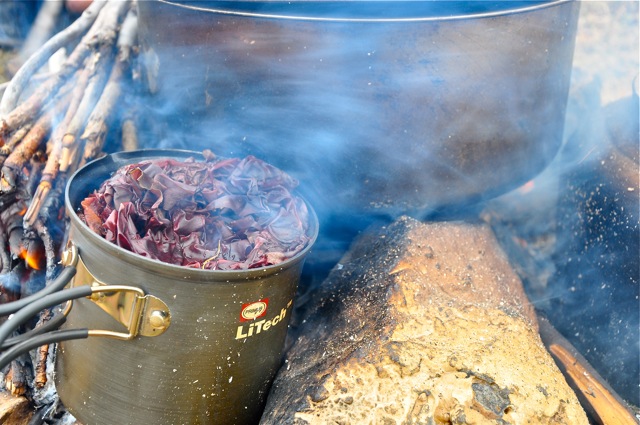
Dulse, harvested in the distant sea is crucial for us to maintain our sodium and potassium levels. I would boil it up and add it to our monotonous noodle feasts
Like many good-byes within the Himalayas, our own from this little home is disjointed, sudden and without any pomp. Gamzon, our guide is perky from her time with family and clearly energized. Terrier is his usual self, though slightly impatient to get on with it. I share his neurotic need to press on and get out of this warm valley, which is slowly strangling me. In the village we have picked up yet more noodles and some strange lumps of glutinous rice candy for the road.
We cut south down a valley that will take us to a divide with one route heading directly south and another cutting back west and then north. We will take the later cut-back, which will take us around the bulk of Amne Machin and hopefully to my old friend the wind.
Cutting in front of a homestead mid-morning we are forced into instant and unthinking action, with our entire team pressed into battle positions. Without warning a massive Tibetan mastiff comes at us dragging a chain, bearing teeth and looking the part of a guardian of the netherworld. Hackles raised, eyes blazing fury he has broken loose from that precious link that held him, and is upon us in a flash. Two slightly less ominous cronies of his, emboldened by their newly released mate’s display are following up on the flanks and in a moment it looks as if damage will be done to our caravan. Michael and I are both thirty yards ahead of the action and it is this that worries me most, that we cannot band together.
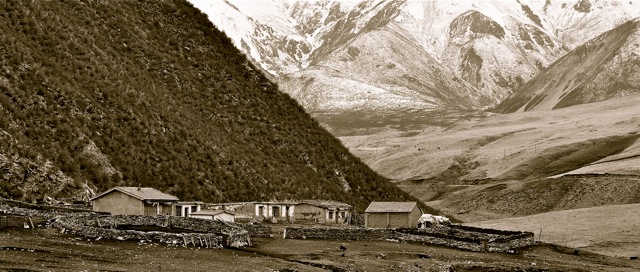
Scenes like this are more common within the folds of mountains – nomadic tents giving way to solid ‘winter’ structures
Michael and I have both taken to carrying flat headed rocks in our pockets for just such occasions, and quickly launch the equivalent of long-bow strikes…but these are too little and too late. The big beast (who looks to be about fifty kilos of rampaging murder) and his cohorts have moved in on our animals, but in a second I realize I have greatly underestimated our unit’s abilities in the blood arts. We are after all in the lands where all living beings are hard and toughened to such eventualities. Our guide Gamzon, on horseback, has instantly turned to face the threat and in doing so has urged our two brute yaks to do the same. The animals stay composed but I realize that our yak have dropped their heads and moved tight to one another forming a formidable phalanx. Their shaggy tails flit nervously – a sign that they are ‘excited’. No dog, however berserk or feral in these regions is unaware of the risk posed by an irate yak and being gored is not on any living thing’s menu plan. Our rampaging black attacker seems to realize the significant threat of yak, Tibetan iron-woman and raw-boned pony at in one moment and attempts to slow his momentum, skidding unceremoniously to a halt and ending up in a seething mess just outside of range of a yak horns. It is then that our own terrier (who has thus far been strangely invisible) moves in with the efficiency of small chainsaw, launching himself onto the exposed groin of the mastiff. His timing and aim are true as he sets about with ferocious efficiency nipping and snarling his way up and down the body of the bigger dog. It is a brutal and efficient display and there is a bit of sympathy in me for the poor mastiff. A moment later the mastiff is hightailing it home, stumbling and yelping, perhaps wondering where all of his bravado went wrong. His two comrades while initially game for battle had retreated earlier, clearly reading the signs of a prolonged and potentially disastrous campaign. Ripper shakes himself off and seems to be greatly enhanced by the activity. Tail held high he prances a bit, making sure to give Michael and I a look ensuring that we have appreciated the performance. I decide then and there that I have a slight crush on this small multi-talented canine. He is the complete partner on this journey – clever, vicious, entirely loyal, charming and understated. His engine seems incapable of breakdown no matter what the situation.

Our caravan and our own figures cut very solitary shapes in the huge expanses. Michael captures me ‘hunting for wind’
Our eventual veering right into another cavernous valley comes amidst still more heavy and almost suffocating air. Odd fence lines swerve and follow the contours of the land – strange to see these very ‘man’ oriented demarcation points. Nomads have long used (successfully) landmarks and informal systems by which to delineate ‘property’. In this remote corner it disconcerts to see these powerful landscapes parceled out into boxes. Amne Machin is no different. It is seen as a great marking upon the earth where deities reside.
It is a day of grinding, with little in the way of spectacles, though the morning’s canine scrap is still fresh in the mind providing me many smirks along the way. Michael wanders on his own taking in the valley and taking time to process. It is like this on intense journeys with bodies convening to share and then moving off again to be alone – it is in this way that the mind and psyche stay sane. I move on ahead searching out winds, silently hoping for their cold caresses to find us once again…and they do.
Funnelling into us, the winds arrive coming straight down from the mountains. There is snow too, mere bits of it at first, and the body instinctively draws comfort. Heat in the mountains for me is a hobgoblin that drains and saps me, creating a seething monster. The cold lights up the entire system giving the mind and body new energy and renewed hope.
In minutes snow is piling into us and I am back to my ‘regular’ self. High above our route, which has narrowed into a mere path, the hunched bodies of caterpillar fungus pickers stoop. A whole population of diligent workers tucked onto the mountainside will work in these extreme conditions for up to two months and will stay in camps that are themselves tucked away in these heights.
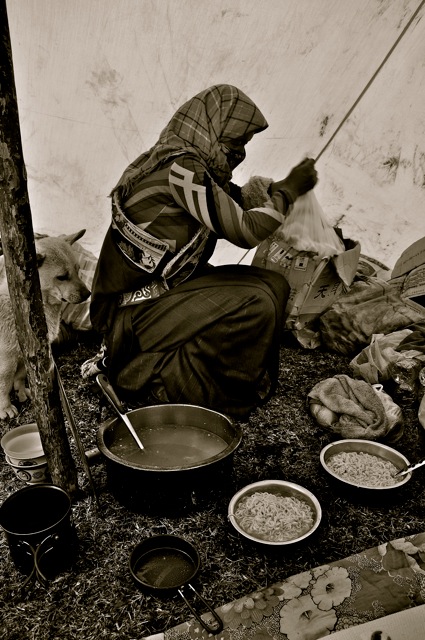
Tucked safely in our tent, Gamzon prepares yet another dinner of noodles. She is being carefully watched by our terrier (left) who keeps an eye on errant scraps. Here, his ‘look’ is far more revealing as to his true nature
Our camp rests above a valley and a cold that hits us in teeth moves in quickly. It hits -8 degrees Celsius and for the first time I actively welcome our miniature body guard into the covers for a well deserved rest. Amne Machin is the conductor weather…at least that is how I play it in my head.


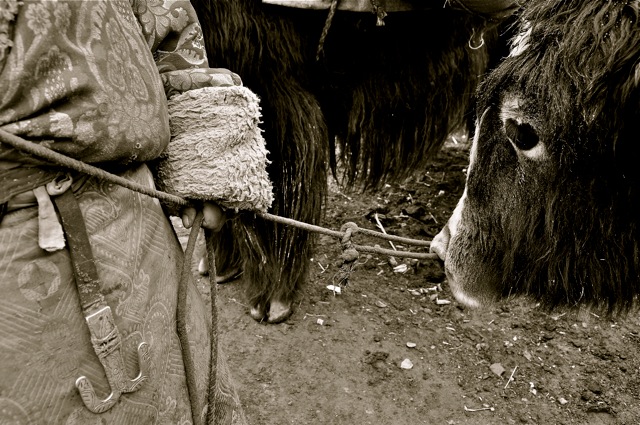

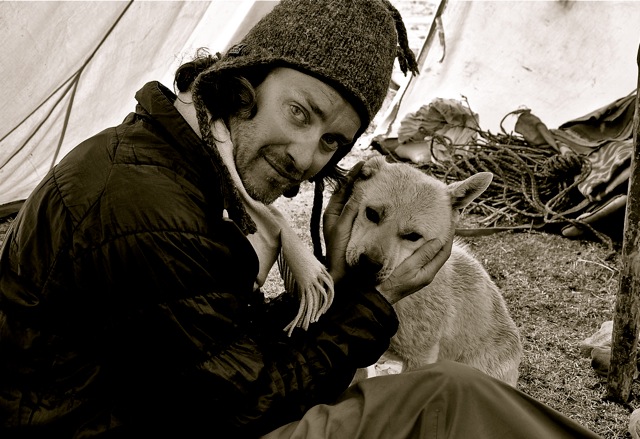

Pingback: Blog posts from Mei Zhang and others about China travel - WildChina
At that time of year there were Siberian winds and snow and in the intense cold during the night, you hear the rocks splitting as they changed from the daytime heat to the night-time cold. That has an effect on the person. I had to become used to sleeping with the horses or the yaks – I much preferred the horses.”
George Patterson (Explorer)
Anyone who has been part of the ‘cold’ and haunted portions of the globe, will always carry the memories and the ‘touch’ of these places. Having said that the stoic might and reliability of the yak we travel with make them my preference for traveling companions…mind you the sleeping with question is till in the air.
Thanks for the note Howard – great quote.
Jeff